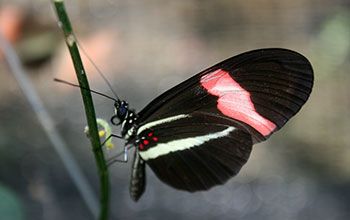Multimedia Gallery
Studying genotype-phenotype relationships in Heliconius butterflies
A research project at the University of Puerto Rico, Rio Piedras, uses butterfly wing color patterns as a mechanism to study genotype-phenotype relationships in Heliconius butterflies.
More about this image
The National Science Foundation (NSF) made eight awards totaling $41.7 million for projects aimed at building capacity to research a national priority area: understanding the relationship in organisms between genetic material, or genotype, and physical characteristics due to gene expression and environmental influences, or phenotype.
The genotype-to-phenotype relationship has significant societal and economic implications across scientific fields and areas of industry, including but not limited to medicine, agriculture, biotechnology and ecology. An enhanced understanding of this relationship holds the potential for improved food crop yields, better prediction of human disease risk and new drug therapies. Through these investments, NSF aims to provide the scientific community with new tools and resources for future discoveries. The awards were made through NSF's Established Program to Stimulate Competitive Research (EPSCoR) as part of its Research Infrastructure Improvement (RII) Track-2 investment strategy.
"Over the past several decades, scientists and engineers have made massive strides in decoding, amassing and storing genomic data," said Denise Barnes, Head of NSF's Established Program to Stimulate Competitive Research (EPSCoR) Program. "But understanding how genomics influence phenotype remains one of the more profound challenges in science. These awards lay the groundwork for closing some of the biggest gaps in biological knowledge and developing interdisciplinary teams needed to address the challenges."
Among the awards made was "In the Genomic logic underlying adaptive morphological divergence," by Riccardo Papa of the University of Puerto Rico, Rio Piedras (UPRRP).
Understanding the genotype-phenotype relationship is an important goal for evolutionary biology, but it remains a challenge due to the complexity of interpreting the connections between networks of interacting genes and evolutionary development mechanisms. Papa's project builds on the complementary expertise of the UPRRP and Mississippi State University and uses butterfly wing color patterns as a mechanism to study genotype-phenotype relationships in Heliconius butterflies. Disentangling these relationships will provide a major advance in understanding how morphological diversity develops and ultimately originates, which would inform research into other organisms.
[Research supported by NSF grant OIA 1736026.]
To learn more, see the NSF News Release NSF EPSCoR awards new projects to help understand connections between genes and organisms' characteristics. Date image taken: 2012-2013; date originally posted to NSF Multimedia Gallery: Dec. 12, 2017)
Credit: Riccardo Papa, Department of Biology, University of Puerto Rico
See other images like this on your iPhone or iPad download NSF Science Zone on the Apple App Store.
Images and other media in the National Science Foundation Multimedia Gallery are available for use in print and electronic material by NSF employees, members of the media, university staff, teachers and the general public. All media in the gallery are intended for personal, educational and nonprofit/non-commercial use only.
Images credited to the National Science Foundation, a federal agency, are in the public domain. The images were created by employees of the United States Government as part of their official duties or prepared by contractors as "works for hire" for NSF. You may freely use NSF-credited images and, at your discretion, credit NSF with a "Courtesy: National Science Foundation" notation.
Additional information about general usage can be found in Conditions.
Also Available:
Download the high-resolution JPG version of the image. (2.8 MB)
Use your mouse to right-click (Mac users may need to Ctrl-click) the link above and choose the option that will save the file or target to your computer.

 All images in this series
All images in this series